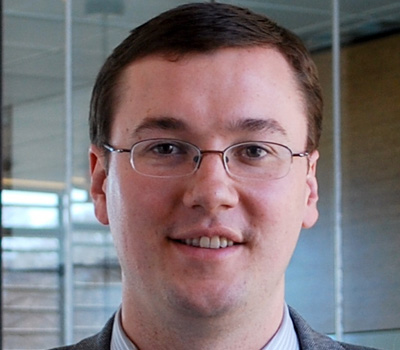Using biologically-inspired approaches to endow synthetic materials with adaptive properties
Nature has made a tremendous diversity of remarkable inventions, adaptations, and designs that have provided humanity with inspiration for engineering applications, including design of spacecraft and submarines. However, many valuable abilities possessed by organisms have been difficult to replicate because of their complexity. Dr. Ryan Hayward, of the University of Massachusetts, Amherst, focuses on the design of biologically-inspired materials that can change their properties upon demand of the user, or that automatically adapt to changes in their environment. In so doing, Dr. Hayward is able to create new materials that impact our lives in many different capacities while mimicking the abilities of natural organisms.
While Dr. Hayward is motivated by fundamental principles, there are many areas in which his research may have a lasting impact. Dr. Hayward and his team expect their technology to be used to create materials for biomedicine that may allow faster healing, less invasive procedures, or more effective interfaces with man-made devices, materials that save energy by turning optical transmission of windows or enable low-power displays, and consumer products including apparel, packaging, and tactile interfaces that can be made with improved properties and in inexpensive ways. In short, using a combination of new approaches to fabricate materials and basic principles of mechanics and geometry, he and his team are able to yield a unique approach to bioinspired materials. Dr. Hayward's mentorship of future scientists in which he helps design experiments and uses creative solutions for longstanding problems in addition to working at a conceptual level that allows his team to create new hypotheses and approaches, has resulted in advances in engineering that at one time may have seemed impossible.
Current projects include:
-
Remarkable Transformations: In one project, Dr. Hayward and his team take advantage of processes of differential expansion or contraction to drive shape changes of structured thin sheets and filaments, a commonly observed strategy in nature (for example, the development of ruffled kale leaves, the opening of pinecones, or the burrowing of certain seeds into the ground). The pattern of expansion or contraction generates stresses within the thin structure that are partially relieved by buckling, leading to remarkable transformations in three-dimensional shape. Dr. Hayward's work has focused on developing new materials that can easily be used to fabricate thin structures with patterns of stress that can be triggered using any number of environmental factors including changes in temperature, humidity, light, pH, or salinity, the application of an electrical or magnetic stimulus, or the introduction of particular chemicals or biomolecules.
-
Rapid Reconfigurability: Nature has devised strategies to overcome the relatively slow time-scales associated with fluid transport and muscular actuation using the principle of 'snap-through' transitions. The idea is to prepare a system in a state where it is locally stable, but just on the verge of buckling into a very different configuration. Examples in biology include prey capture by Venus flytraps and hummingbirds, while those in man-made structures include toys such as poppers and slap bracelets. Dr. Hayward has focused on elucidating simple geometric principles that allow he and his team to introduce such snap transitions into a wide variety of structures and material systems, and on fabricating new types of rapidly reconfigurable materials based on these ideas.
- Changing Color: Dr. Hayward has been inspired by the amazing ability of certain animals, notably cephalopods (e.g., squids, octopuses, cuttlefish) to camouflage themselves by changing color. While most colors we see around us rely on the selective absorption or emission of certain wavelengths of light, these organisms also make use of photonic structures that yield color through interference of light. Dr. Hayward and his team have focused on the design of photonic multilayer structures that can be modulated by a variety of stimuli to give rise to changes in color. In addition to their promise for adaptive camouflage, Dr. Hayward anticipates that these materials may have applications in displays and energy-efficient coatings.
Bio
Ryan Hayward is an Associate Professor of Polymer Science and Engineering at the University of Massachusetts Amherst. He received degrees in Chemical Engineering from Princeton University (B.S.E, 1999) and the University of California, Santa Barbara (Ph.D., 2004), and was a postdoctoral fellow in Engineering and Applied Sciences at Harvard University from 2004-2005. His group's research covers a variety of topics in polymers and soft materials, with a focus on thin films and interfaces. Recent areas of interest include swelling-induced deformation of constrained and micro-patterned stimuli-responsive gels, and solution state self-assembly of polymer and particle-based nanostructures. Ryan has received several awards, including the Presidential Early Career Award for Scientists and Engineers (PECASE), the 2013 Journal of Polymer Science Innovation Award, and the 2014 John H. Dillon Medal of the American Physical Society. He currently serves as an Associate Editor for the journal ACS Macro Letters.
As an undergraduate student, Dr. Hayward was very fortunate to have several opportunities to participate in research. In particular, during his senior thesis research, he found that he simply enjoyed the time doing science in the lab and thinking about his research far more than he ever imagined. He was hooked by the ability to discover new things, the freedom to pursue new ideas, and the promise of making discoveries that could impact people's lives.
In addition, to research, Dr. Hayward also stays quite active. He enjoys hiking with his German Shepherd, skiing, and running.
Website: http://www.pse.umass.edu/faculty/researchgroup/hayward
In the News
Chemical & Engineering News
Nature Publishing Group
AIP Scitation
Publications
Awards
Dudley A. Saville Lecturer, Princeton University, 2014
American Physical Society John H. Dillon Medal, 2014
Journal of Polymer Science Innovation Award, 2013
ACS Division of Colloid and Surface Chemistry Unilever Award, 2011
Presidential Early Career Award for Scientists and Engineers, NSF, 2010
Patents
US Patent No. 12/464,306: "Wrinkled adhesive surfaces and methods for the preparation thereof".
A.J. Crosby, E.P. Chan, R.C. Hayward.


